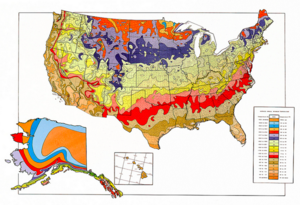
Plant hardiness zones define the zones in which plant species and cultivars can be grown. A plant's hardiness can be determined by description or by a zonal numbering.
However the hardiness of a plant is defined, local conditions always matter, and the type of protection offered either by nature (such as snow cover) or by human intervention (such as wrapping a plant, sheltering it or bringing it out of direct weather) can alter the hardiness of a plant.
The zonal system[edit | edit source]
The hardiness of a plant species or cultivar is shown by a zone number in the zonal system. The zonal system was developed by the Agricultural Research Service of the US department of Agriculture. It is important to understand that the zonal system is one of guidance, not absolute guarantees and local variations and micro-climates will introduce their own effects upon the ability of a plant to thrive or survive.
In all, there are 11 zones. Each zone is based on the average minimum temperature in the relevant geographical zone. For each zone rating, a plant recommended for that zone should be able to survive a winter period provided that it has been planted under the correct conditions. If the plant could not survive, it means that the plant is not suitable for the area or that other arrangements should be made for its optimal growth, such as using a greenhouse, bringing it inside during winter or sheltering or covering it in some appropriate way.
The zones are as follows:
- Zone 1 Below -45ºC (-50ºF)
- Zone 2 -45ºC to -40ºC (-50 to -40ºF)
- Zone 3 -40 to -34ºC (-40 to -30ºF)
- Zone 4 -34 to -29ºC (-30 to -20ºF)
- Zone 5 -29 to -23ºC (-20 to 10ºF)
- Zone 6 -23 to -18ºC (-10 to 0ºF)
- Zone 7 -18 to -12ºC (0 to 10ºF)
- Zone 8 -12 to -7ºC (10 to 20ºF)
- Zone 9 -7 to -1ºC (20 to 30ºF)
- Zone 10 -1 to 4ºC (30 to 40ºF)
- Zone 11 Above 4ºC (40ºF)
Hardiness descriptors[edit | edit source]
Another way to explain the hardiness of plants is to describe the type of hardiness:
- Frost tender - The plant may be damaged by temperatures below 5ºC (41ºF). This plant would need to be kept in a greenhouse or indoors during the winter period.
- Half hardy - This plant may be damaged by temperatures below 0ºC (32ºF). This plant would need to be kept in a greenhouse or indoors during the winter period.
- Frost hardy - This plant can survive cold temperatures to -5ºC (23ºF). With some protection, shelter or cover, this plant might be able to remain outdoors during a mild winter climate.
- Fully hardy – This plant can tolerate temperatures to -15ºC (5ºF). It can be left outside during winter in many places.
The need to pair cold zones with heat zones[edit | edit source]
As well as knowing how hardy a plant is in a cold zone, the heat zone must also be understood. This is because a cold zone indicator does not necessarily indicate the same range of summer season heat that a plant will be exposed to. Two different areas of a country or region may experience the same cold zone but have vastly different heat zones during the summertime. As such, a plant that may thrive according to the cold zone might fail to thrive in one area where the heat it much higher than in another zone. The heat zones must also be accounted for and there are also Heat Zone maps for areas that can be paired with the Cold Zone maps. Heat zone are arranged into 14 divisions, decided by the number of days above 30ºC.
- For the USA, see the American Horticultural Society at http://www.ahs.org/gardening-resources/gardening-maps/heat-zone-map.
- For Australia, see The Diggers' Club at https://www.diggers.com.au/shop/ordering-information/climate-maps/